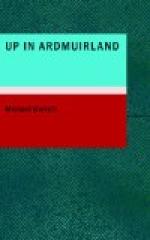If I did not know for certain that Longfellow never set eyes on Ardmuirland, I should maintain that the lines at the head of this chapter were meant for a description of it. For “the steel-blue rim of the ocean” is but three miles distant from this heather-clad, wind-swept height, which rises some seven hundred feet above it. Moreover, as one gazes down, the eye meets many a miniature forest of pine and birch, clothing portions of the lower hills, or nestling in the crevices of the numerous watercourses which divide them. Strewn irregularly over the landscape are white-walled, low-roofed farms and crofters’ dwellings—each in the embrace of sheltering barn and byre, whose roofs of vivid scarlet often shine out in the sun from a setting of green meadow or garden.
Our own habitation is simple enough, yet amply suffices for our needs. It is just a stone cottage of two stories, and is connected by a small cloister-like passage, Gothic in character, with the stone chapel which is the scene of Val’s priestly ministrations. This, too, is modest enough. The windows are triple lancets, filled with opaque glass, the altar of stone and marble, but simple in decoration, the tabernacle of brass, and the eastern window—larger than the others—is embellished with stained glass. It is in memory of our dear Dad, and besides his patron, St. Andrew, it has the figures of St. Valentine and St. Edmund on either side of the Apostle.
Within the house is a dining-room, a better furnished room for the reception of important visitors, and a small den known as the “priest’s room,” in which Val interviews members of his flock. Upstairs are Val’s study and my sitting-room, with our respective bed-chambers and a spare one for a casual visitor. Kitchen offices and servants’ quarters are in a tiny special block.
Both chapel and house have been built by Val. I can recall his pleading letters to Dad for help to raise a more worthy temple. The Pater, with his characteristic caution, made it a condition of his help that a new house should form part of the plan. If the old chapel was as unworthy of its purpose as Val’s descriptions painted it, the dwelling must have been indeed poverty-stricken. From what I have gleaned from the natives, both buildings must have surpassed in meanness our wildest conceptions of them. But more upon that subject later.
Any account of the chapel-house at Ardmuirland would be incomplete without some reference to a personage who holds an important position in the household, second only to that of the master of the house. This is Penelope Spence, known to the world outside as “Mistress Spence,” and to Val and myself as “Penny.” She was our nurse long ago, and is now the ruler of the domestic affairs of the chapel-house. A little, round, white-haired, rosy-faced dumpling of a woman is Penny; an Englishwoman, too, from the Midlands, where the letter H is reserved by many persons of her social standing for the sake




